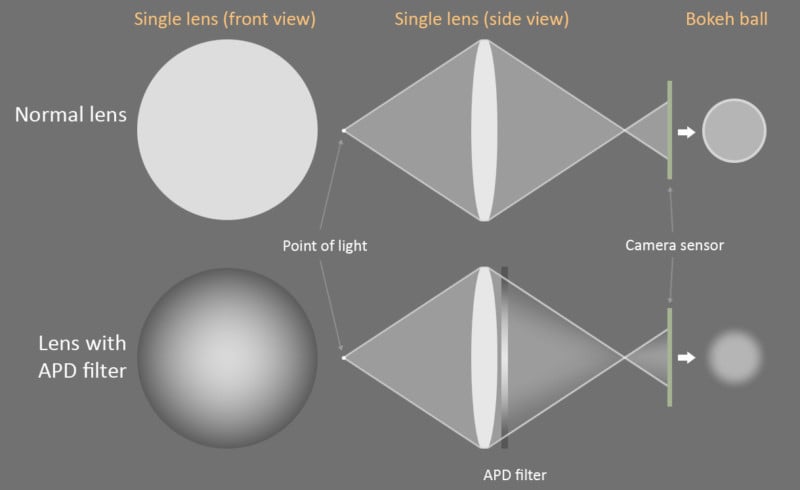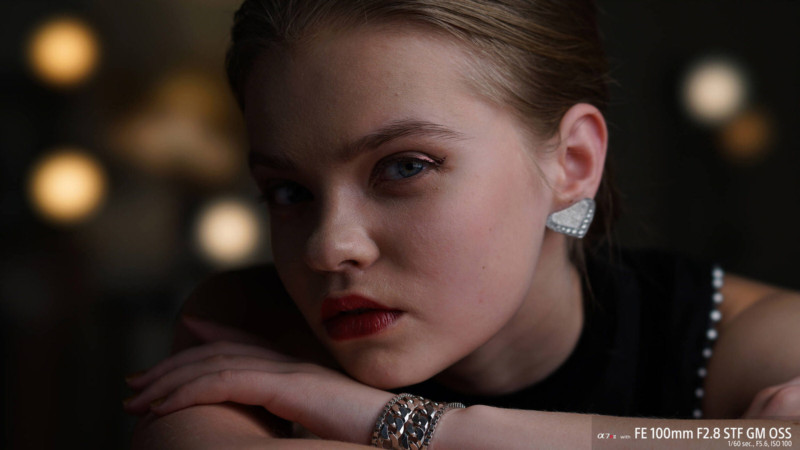How to Get STF-Style Bokeh Without a $1,000+ STF Lens
![]()
Smooth Trans Focus (STF) was invented by Minolta in the 1980s and became available in the Minolta 135mm f/2.8 STF in 1999. The special design of the lens with an Apodization (APD) filter allows for the smoothing of out-of-focus areas, or bokeh. The APD filter reduces the light transmitted through a lens, but the strength is gradually decreased toward the center of the filter.

Currently, there are a few STF lenses are available, including the $1,399 Minolta/Sony 135mm f/2.8 STF, $1,499 Sony FE 100mm f/2.8 OSS STF GM, $1,499 Fujifilm XF 56mm f/1.2 R APD, and $599 Venus Optics Laowa 105mm f/2 STF. Except in the case of the Laowa lens, all the STF lenses are quite expensive (over $1,000), so not many people may have a chance to use them.
Some people love the look of STF bokeh, while others may not like (or even hate) it, but that’s not what I’m discussing in this post. Since I’m interested in the technical side of things, I was wondering if there exists a way we can imitate the STF effect without the need of an APD filter or expensive STF lens.

The solution I came up with can do the same thing as an APD filter (with some limitations, of course).
The Variable Aperture Approach
I realized that the lens diaphragm can mimic the mechanism of an APD filter if the aperture blades are allowed to open up or close down while the sensor is being exposed. That means the bokeh that I get in the final image will be the cumulative image of variable apertures, and theoretically, it should look diffused in the style of an APD filter.
To quickly test and demonstrate this concept, I shot photos with an early version of the Helios 44 58mm f/2 lens, which has 13 round blades. On my Sony a7 Mark II, I set the timer to 2s and 1/30s speeds so that my hand was quick enough to sync the movement of the blades to the shutter. I pressed the shooting button, waited 2 seconds and immediately rotated the aperture ring to stop down the lens to about f/4 from f/2. Later, I checked the photos and I found some of them actually showed the diffuse bokeh effect. The bokeh is something between f/2 and f/4, and the level of blurring the edge of the bokeh ball depends on the speed of stopping down the lens.
![]()
Examining the bokeh, I concluded that my approach is much more feasible if the speed is long enough and the camera is vibration-free. Therefore, in my second experiment, I used a cine lens (SLR Magic 35mm f/1.2 CINE) with a smooth, declicked, and rounded aperture, and I fixed the camera on a steady tripod and shot a long exposure (up to 6 sec).
With plenty of time for changing the aperture during the exposure, I found it much easier to control the outcome. Also, unlike my rough demonstration, this time I started with a small aperture and opened the iris during the 6 seconds of exposure. This reversed way makes it easier to control the size of the bokeh balls.
The most STF-like effect was achieved when I slowly opened the aperture from f/4 to f/2 and increased the speed until I reached f/1.2. The non-linear speed made the bokeh bright in the center while quickly turning dark toward the edge.
![]()
So what kind of lens do you need for this technique? At first, I thought that a lens with many round blades is essential, but it turned out that even a lens with few straight-blades can do the job. That was the case with the 9-bladed Meike 35mm f/1.7 that I tested on a Sony a6300. Since the aperture blades were actually rotating when I shot, I never observed the polygonal bokeh shape as I shot with a stopped-down aperture. As long as the lens has a smooth manually controlled aperture ring and it’s declicked, then it should be suitable for this technique.
![]()
It’s a nice effect and quite easy to shoot if you’re shooting still at night and have a tripod with you, otherwise, the technique is not practical to do with fast shutter speed (unless, perhaps, you use a neutral density filter).
In the case that you want to mimic the STF effect in daylight shooting, there also another option for you.
Minolta’s STF Simulation, or Aperture Bracketing
Minolta was not only the company that invented the STF lens, but they also provided an alternative way to achieve the same effect through the STF mode built into the Maxxum 7/Alpha 7 camera for people who don’t have an STF lens. The way this mode works is by combining 7 bracketed photos taken with a 0.3-stop aperture interval without changing the focal point. I didn’t know about this method until someone mentioned that my approach is similar to Minolta’s. They use the same principle but are slightly different in the technique and the effect.
Since I don’t have a Maxxum 7, I used the same technique to shoot 7-8 photos with different apertures (from f/5.6 to f/2) and combined them afterward in Photoshop. First, I imported all the photos as stacking layers, aligned and converted them to a smart object, then stacked the layers using the Mean stacking feature.
You can see in this example shot with the Helios 44, the bokeh became much smoother than the shot at f/2.
![]()
The key difference between two methods is whether the changes in aperture is stepless or not. The bracketing method produces the average of countable images, but the variable aperture method captures the cumulative image resulted from an uncountable aperture range.
Minolta’s approach can be done with any shutter speed, but the result may be less satisfactory, especially when the bokeh ball size is big and the lens is over-corrected for spherical aberration (or when the bokeh ball has bright, sharp edge). As illustrated in the graph below, at the extreme case, the difference in the bokeh can be seen (otherwise I found that the difference is just marginal).
![]()
I did a comparison of the two methods using the same scene. With an extension tube to get the Helios 44 closer to the subject to enlarge the bokeh balls, I can see that the bracketing method resulted in bokeh balls with clear lines between bokeh layer, while my method produced smoother bokeh. Controlling the speed of opening the aperture, I can create a strange bokeh as you can see in the last photo (onion-like but in a good way) by slowing down the ring rotation speed several times.
![]()
![]()
The good thing about the bracketing method is you can do it even at a fast shutter speed under daylight conditions. If the lens doesn’t have strong bokeh edge, then the final effect can be really smooth, as when I used Canon EF 100mm f/2 USM to test.
![]()
In-Camera STF Modes?
The common limitation of both the methods is that we can’t apply them to portrait or action photos. And actually because of that, I wrote this post to introduce the idea and offer a suggestion to camera and lens makers: could you please engineer a camera with built-in STF modes?
It could be done by enabling the aperture to open or close during the exposure instead of fixing the aperture right before the exposure. If the blade speed can be controlled and be faster than the shutter speed, it may be possible to create the STF effect in most shooting situations. Aperture bracketing could also be used with the images combined and processed in-camera.
It would be nice to have the option to shoot STF-style bokeh without chaining yourself to an APD filter that always reduces light by a few stops and prevents you from capturing “normal” bokeh.
Some people have argued to me that Sony would not get any benefit out of this type of feature because they already sell STF lenses — if Sony cameras had STF modes, who would still buy the STF lenses? But I don’t think it’s an issue because these modes can’t work with movie recording, and there are some limitations in blade speed that it can’t be precisely controlled at very high shutter speed (or it can add more vibrations that potentially reduce image quality). It would simply be added value to all the future lenses that support these modes.
For now, at least we can have fun with bokelicious still photography without breaking the bank.
About the author: Dr. Le Minh Bui is a photographer based in Asia and a member of the Genome and Peptide Engineering Laboratory at the Korea Advanced Institute of Science and Technology. The opinions expressed in this article are solely those of the author. You can find more of his work on his Facebook, Flickr, and 500px.